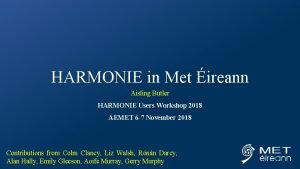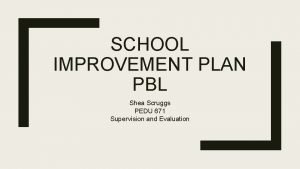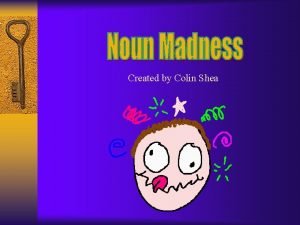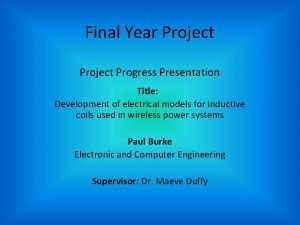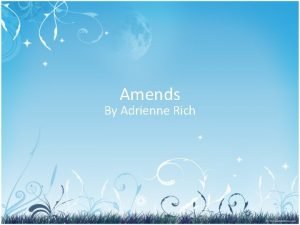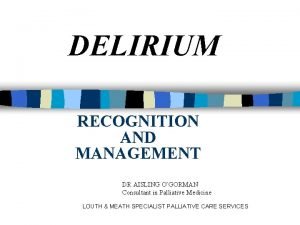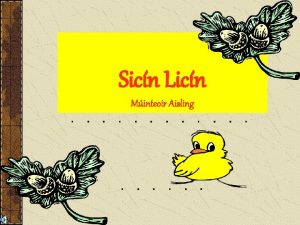ECE FINAL PRESENTATION ADRIENNE PREEYA AISLING SHEA Adrienne






















- Slides: 22

ECE FINAL PRESENTATION ADRIENNE PREEYA AISLING SHEA

Adrienne Coulter Aisling Casey Preeya D’Mello Shea Cassidy (& Kangaroo Friend)

SENSOR CHARACTERIZATION • Sonar Sensor • Uses “echoes” of sound waves to locate an object’s distance • The closer the distance, the larger the reading on the handy board

SONAR SENSOR CODE void main() { int range=0; printf("n Sensor Sample Program"); while(!start_button()); // Press Start Button while(1) // Continue infinitely { sleep(0. 5); range = sonar(); printf("n. Output is %d", range); } }

SENSOR CHARACTERIZATION Sonar Reading 1200 1000 800 600 400 200 0 0 5 10 15 20 25 30 35 40 45

SENSOR CHARACTERIZATION • Light Sensor • Records the darkness/lightness of on object or scale, and converts them into readings • Complete black was 100% on the scale, while complete white was 0% • Low values indicate bright light, while larger values indicate low light

LIGHT SENSOR CODE void main() { int sensor 1=0; printf("n Light Sensor Sample"); while(!start_button()); // Press Start Button while(1) { sleep(0. 5); // Continue infinitely sensor 1=analog(4); // Reads the signal coming from analog port 4. printf ("n Light. Sensor%d", sensor 1); } }

SENSOR CHARACTERIZATION Light Reading 200 180 160 140 120 100 80 60 40 20 0 0 1 2 3 4 5 6 7 8

CIRCUITS • To begin our work with circuits, we calculated theoretical values of voltage drops, current and resistance in various prompted circuits • Ohm’s Law: V=IR • We distinguished parallel and series circuits • Resistance in series: Req= R 1 + R 2 • Resistance in parallel: 1/Req=1/R 1+1/R 2

DC CIRCUITS • Materials for DC: breadboard, resistors, a diode, a DC Power Supply, and a multimeter. • The breadboard was the main component of the circuit. • Resistors and diodes were used to build parallel and series circuits. • Once the circuit was built we hooked up a DC Power Supply to the bread board using wires. This sent current throughout the bread board. • We used wires to connect a multimeter to our breadboard. The multimeter measured the voltage across each resistor, current through the circuit and resistance.

AC CIRCUITS • Materials for AC: BNC cable, a banana, 2 mini-grabbers, a function generator for AC current and an oscilloscope. • We connected the circuit to the function generator for an AC power source supply, and analyzed the graph of the current on the oscilloscope. • We determined the frequency and amplitude (voltage) for the various circuits.

INSTRUMENTATION DC Power Supply Multimeter Supplies power to a circuit. Between 25 V and 25 V Measures current, voltage and resistance through a circuit

INSTRUMENTATION Oscilloscope: measures and graph how voltage changes with time

MULTISIM • In this lab we further explored the mechanisms of circuitry. We built virtual circuits that we could test without having to physically build them. We used a virtual multimeter to measure the voltage and current through each circuit. We then used a virtual oscilliscope to see how the voltage changed over the course of time.

AM RADIO LAB • Materials: printed circuit board, resistors, capacitors, semiconductors, & other parts • We soldered in order to connect the wires in the circuit. This required a soldering iron, solder, and dexterity. • We picked up a news station and a latin music station.

AM RADIO LAB

ARDUINO LAB WEEK 1 • In this lab, we built a circuit and became familiar Arduino to program an LED to light up with varying levels of brightness and colors.

LED CODE int REDPin = 3; // RED pin of the LED to PWM pin 3 int GREENPin = 5; // GREEN pin of the LED to PWM pin 5 if (brightness <= 0 || brightness >= 255) direction of the fading // reverse the { int BLUEPin = 6; increment = -increment; // BLUE pin of the LED to PWM pin 6 } int brightness = 0; // LED brightness = constrain(brightness, 0, 255); //function int increment = 5; // brightness increment (changing this will change the which limits a value to a range smoothness of transitions) analog. Write(REDPin, brightness); void setup() //analog. Write(GREENPin, brightness); { pin. Mode(REDPin, OUTPUT); analog. Write(BLUEPin, brightness); pin. Mode(GREENPin, OUTPUT); //blue pin value refresh pin. Mode(BLUEPin, OUTPUT); //blue pin mode definition } effect void loop() } { brightness = brightness + increment; // increment brightness for next loop iteration delay(2); // wait for 20 milliseconds to see the dimming

LED

ARDUINO LAB WEEK 2 • We used our programming skills from the previous part to program a motor to rotate based on its light sensitivity.

MOTOR CODE int servo. Pin = 4; //variable to store the servo pin number int pulse = 700; //variable to store the pulse duration void setup() { pin. Mode(servo. Pin, OUTPUT); //set the servo pin as an output Serial. begin(9600); //set serial data transfer rate } void loop() { digital. Write(servo. Pin, HIGH); //send 5 V to the servo delay. Microseconds(pulse); //for pulse microseconds digital. Write(servo. Pin, LOW); //send 0 V to the servo delay(20); } //for 20 milliseconds

• Worked as a team to execute these projects CONCLUSION ECE 1020 Section 30 Aisling Casey Shea Cassidy Adrienne Coulter Preeya D’Mello • Consulted with one another when faced with a complication or problem
 Aisling doherty
Aisling doherty Aisling conboy
Aisling conboy Dr eimear ruane-mcateer
Dr eimear ruane-mcateer Aisling treacy
Aisling treacy Aisling enright
Aisling enright Aisling butler
Aisling butler Shea scruggs
Shea scruggs Heidi chamberlain
Heidi chamberlain Mr colin shea
Mr colin shea Shea maloney
Shea maloney Donna shea
Donna shea Shea moisture revenue
Shea moisture revenue Shea thorvaldsen
Shea thorvaldsen Dr. heidi shea
Dr. heidi shea Pauline o'shea
Pauline o'shea Susan o shea
Susan o shea Dr heidi shea
Dr heidi shea Markstrat final presentation
Markstrat final presentation Project seminar presentation
Project seminar presentation Final year project presentation slides
Final year project presentation slides Senior project presentation template
Senior project presentation template Final presentation slide
Final presentation slide Fyp presentation template
Fyp presentation template





